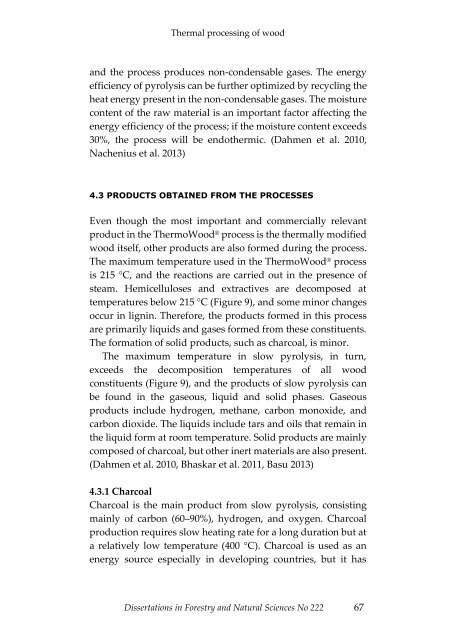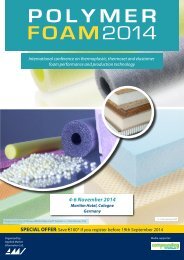Dissertations in Forestry and Natural Sciences
24lYKFN
24lYKFN
Create successful ePaper yourself
Turn your PDF publications into a flip-book with our unique Google optimized e-Paper software.
Thermal process<strong>in</strong>g of wood<br />
<strong>and</strong> the process produces non-condensable gases. The energy<br />
efficiency of pyrolysis can be further optimized by recycl<strong>in</strong>g the<br />
heat energy present <strong>in</strong> the non-condensable gases. The moisture<br />
content of the raw material is an important factor affect<strong>in</strong>g the<br />
energy efficiency of the process; if the moisture content exceeds<br />
30%, the process will be endothermic. (Dahmen et al. 2010,<br />
Nachenius et al. 2013)<br />
4.3 PRODUCTS OBTAINED FROM THE PROCESSES<br />
Even though the most important <strong>and</strong> commercially relevant<br />
product <strong>in</strong> the ThermoWood ® process is the thermally modified<br />
wood itself, other products are also formed dur<strong>in</strong>g the process.<br />
The maximum temperature used <strong>in</strong> the ThermoWood ® process<br />
is 215 °C, <strong>and</strong> the reactions are carried out <strong>in</strong> the presence of<br />
steam. Hemicelluloses <strong>and</strong> extractives are decomposed at<br />
temperatures below 215 °C (Figure 9), <strong>and</strong> some m<strong>in</strong>or changes<br />
occur <strong>in</strong> lign<strong>in</strong>. Therefore, the products formed <strong>in</strong> this process<br />
are primarily liquids <strong>and</strong> gases formed from these constituents.<br />
The formation of solid products, such as charcoal, is m<strong>in</strong>or.<br />
The maximum temperature <strong>in</strong> slow pyrolysis, <strong>in</strong> turn,<br />
exceeds the decomposition temperatures of all wood<br />
constituents (Figure 9), <strong>and</strong> the products of slow pyrolysis can<br />
be found <strong>in</strong> the gaseous, liquid <strong>and</strong> solid phases. Gaseous<br />
products <strong>in</strong>clude hydrogen, methane, carbon monoxide, <strong>and</strong><br />
carbon dioxide. The liquids <strong>in</strong>clude tars <strong>and</strong> oils that rema<strong>in</strong> <strong>in</strong><br />
the liquid form at room temperature. Solid products are ma<strong>in</strong>ly<br />
composed of charcoal, but other <strong>in</strong>ert materials are also present.<br />
(Dahmen et al. 2010, Bhaskar et al. 2011, Basu 2013)<br />
4.3.1 Charcoal<br />
Charcoal is the ma<strong>in</strong> product from slow pyrolysis, consist<strong>in</strong>g<br />
ma<strong>in</strong>ly of carbon (60–90%), hydrogen, <strong>and</strong> oxygen. Charcoal<br />
production requires slow heat<strong>in</strong>g rate for a long duration but at<br />
a relatively low temperature (400 °C). Charcoal is used as an<br />
energy source especially <strong>in</strong> develop<strong>in</strong>g countries, but it has<br />
<strong>Dissertations</strong> <strong>in</strong> <strong>Forestry</strong> <strong>and</strong> <strong>Natural</strong> <strong>Sciences</strong> No 222 67



